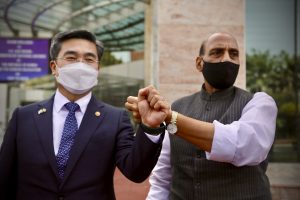South Korean Defense Minister Suh Wook was in India last week, giving a boost to rapidly growing India-South Korea defense and security ties. As an Indian Ministry of Defense press release put it, “The defence and security engagements between India and RoK have grown exponentially over the last few years. Latest talks explored new domains of bilateral defence cooperation and avenues to strengthen the long-standing bilateral defence partnership.”
New Delhi and Seoul raised the level of their relations to a Special Strategic Partnership in 2015 and since then periodic high-level visits and consultations between the two sides have maintained the tempo in bilateral ties.
Suh reportedly held detailed discussions on ways to strengthen India-South Korea defense exchanges and security cooperation with his Indian counterpart, Rajnath Singh. The two sides reviewed the state of relations and appreciated the depth and breadth of their bilateral defense ties across the three services of the two militaries as well as between the agencies handling defense technology and industry. Following the meeting, Singh tweeted to say that they discussed ways to deepen their defense engagements. During the meeting, media reports noted that the two countries also made a decision to undertake co-production and co-development of military hardware, strengthen intelligence collaboration, and step up partnership in space and cyber sectors as part of the broadened defense and security relations. Singh had invited South Korean defense industries to invest in India during his visit to Seoul in 2019, stating that they could use India as a “spring board to export defense equipment manufactured in India to various friendly countries in South East Asia, Middle Asia, Middle East Asia, South Asia and Africa.”
South Korea has also been keen to strengthen its presence in the Indian defense market. In 2019, the two countries put in place a roadmap that will streamline and strengthen bilateral defense industry collaboration. This assumes significance in the context of the Indian decision a few years ago not to use Chinese systems and components in the defense electronics sector. But India is still in the process of establishing its domestic capabilities. Given the urgent need address this capacity deficit, this partnership can be mutually beneficial and ease South Korean participation in the defense sector.
Broader defense trade including naval and land platforms are also of particular interest to South Korea, which is keen to get a share of the Indian defense pie. For instance, some reports suggested that the South Korean deal to sell the Indian armed forces the self-propelled air defense gun missile system (SPAD-GMS), which India was earlier reported to have cancelled, might still be on the table. The Indian Army has made a request for five regiments of SPAD-GMAS. Following a series of trials involving Russian and Korean systems, K-30 Biho of Hanwha Defense of South Korea was shortlisted. Further negotiations have been delayed on account of a Russian protest and the case has been referred to an internal committee. Other reports suggested that the deal for the air defense system has been cancelled and New Delhi is now pursuing a ”Make in India” route. The decision has apparently been taken to reduce the Indian military’s dependence on foreign acquisitions, but Seoul was stunned by the Indian decision to cancel the deal. Nevertheless, South Korea has also shown some flexibility to partner with Indian companies through joint venture route so that the Indian “Aatmanirbhar Bharat” (self-reliant India) initiative can be pushed along.
After his meetings with Singh and others in Delhi on March 26, Suh travelled to the headquarters of the Indian Army’s parachute brigade in Agra to witness a demonstration of air insertion involving a para battalion. Such demonstrations are rarely done for visiting dignitaries, and demonstrates the growing comfort and closer linkages between New Delhi and Seoul. The growing number of interactions and security consultations are an iteration of the strategic congruence between South Korea’s New Southern Policy and India’s Act East Policy. China’s aggressive behavior across the region also figured during the ministerial talks, according to reports.
In December 2020, Indian Army Chief General Manoj Mukund Naravane was in South Korea. It was the first visit by an Indian Army chief to South Korea, highlighting the bold push that the two countries are giving to their bilateral security partnership. The Indian general met with several important officials including Suh, Chairman of Joint Chiefs of Staffs General Won In-choul, Defense Acquisition Program Administration Minister Kang Eun-ho, Naravane’s counterpart General Nam Yeong-shin, and President of the Agency of Defense Development Nam Sae-kyu. Apart from discussing the impact of the COVID-19 pandemic on the military in both countries, the leaders deliberated on developments in the Korean Peninsula and the broader Indo-Pacific. They also agreed on the need to bolster cooperation including on humanitarian assistance and disaster relief (HADR) and anti-piracy missions.
While South Korea and China maintain reasonably stable economic ties, Beijing’s harsh response and sanctions on Seoul for the deployment of the U.S. missile defense interceptor has soured the relationship. This also pushed South Korea to pursue a diversified foreign policy, with strategic outreach toward South and Southeast Asia. India has emerged as a favorable partner in this new strategic web. As India continues to face an aggressive China on its border and in the Indian neighborhood, New Delhi is also keen to get a bigger footprint in China’s neighborhood. This partnership is therefore a win-win for New Delhi and Seoul.

































